Construction Regulation in Victoria
VerifiedAdded on 2022/09/11
|11
|2467
|28
AI Summary
Contribute Materials
Your contribution can guide someone’s learning journey. Share your
documents today.
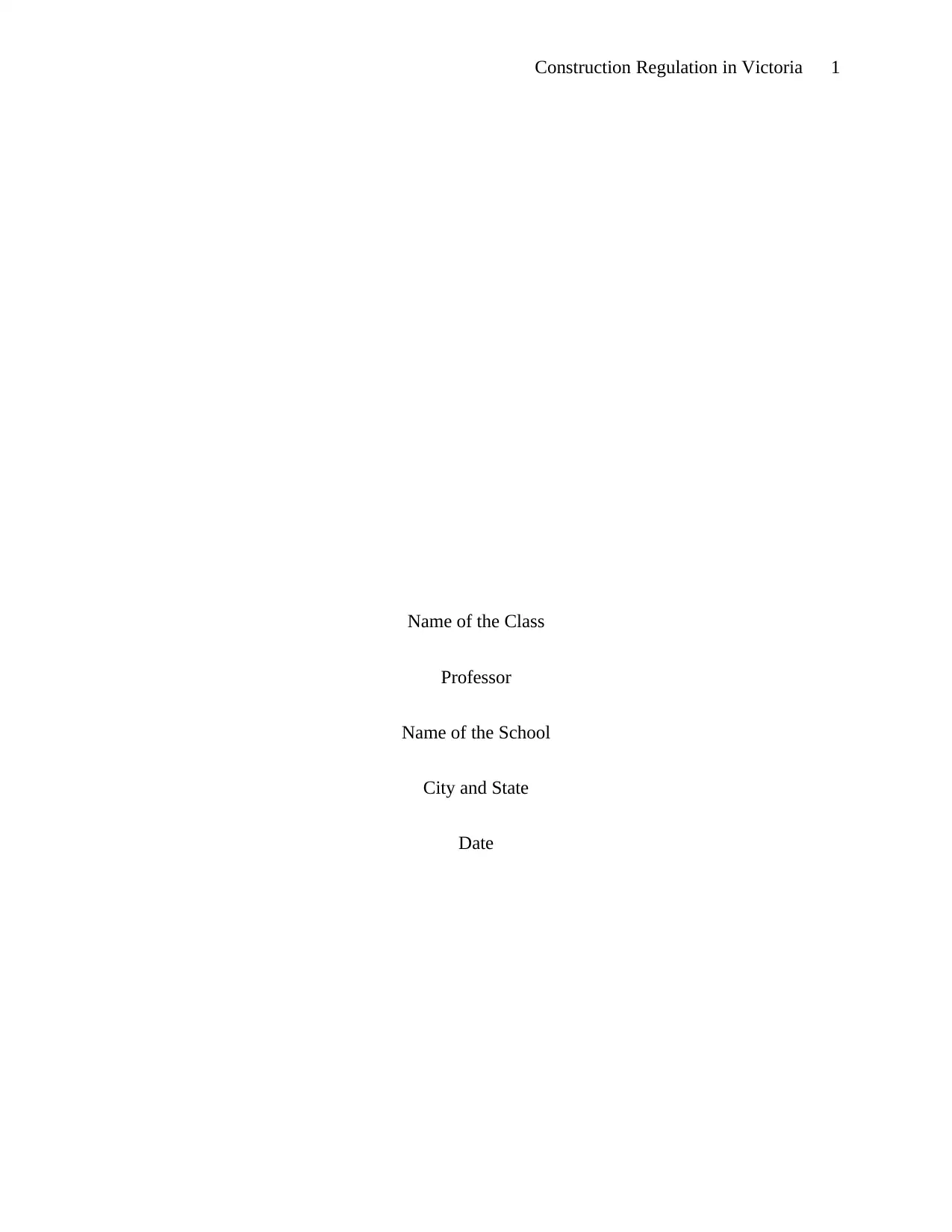
Construction Regulation in Victoria 1
Name of the Class
Professor
Name of the School
City and State
Date
Name of the Class
Professor
Name of the School
City and State
Date
Secure Best Marks with AI Grader
Need help grading? Try our AI Grader for instant feedback on your assignments.
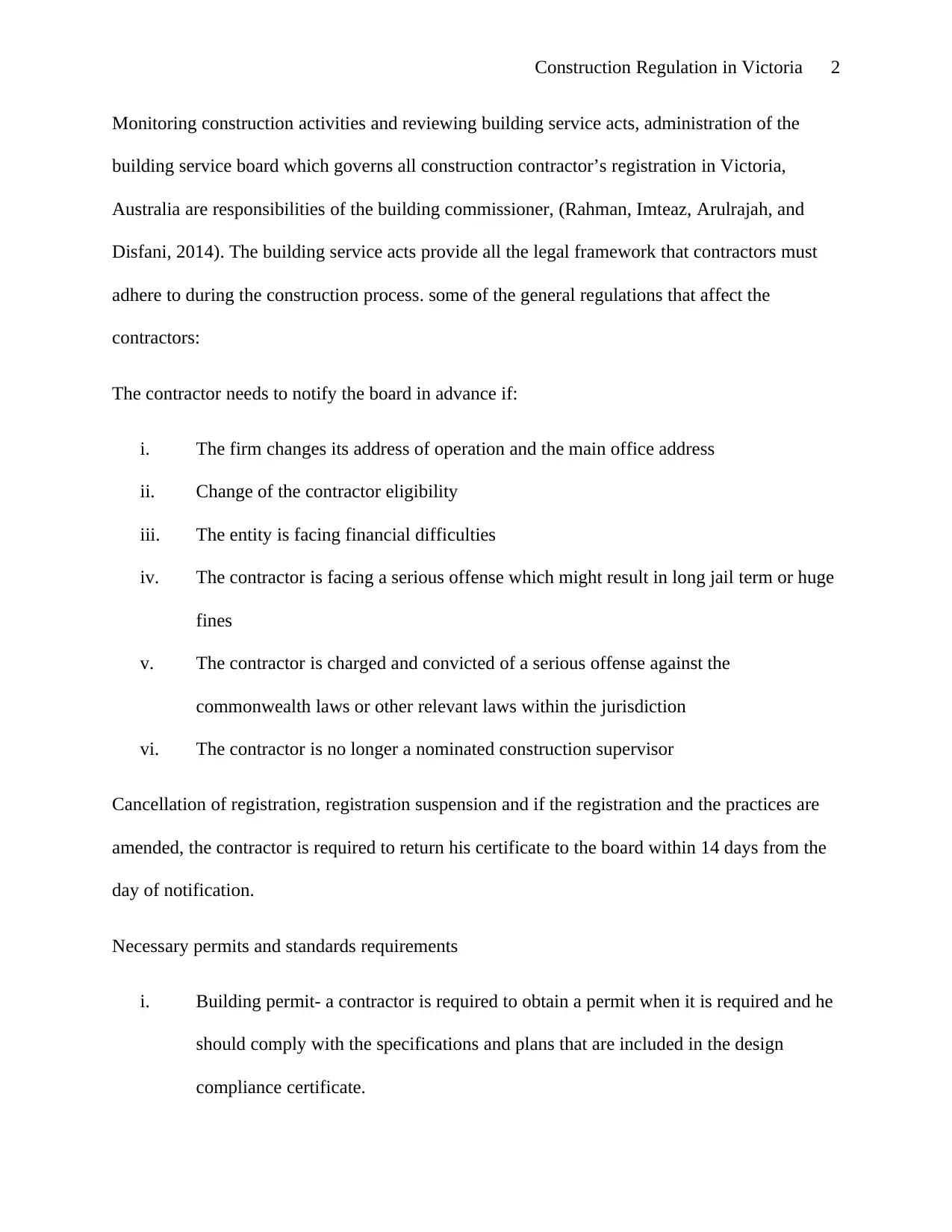
Construction Regulation in Victoria 2
Monitoring construction activities and reviewing building service acts, administration of the
building service board which governs all construction contractor’s registration in Victoria,
Australia are responsibilities of the building commissioner, (Rahman, Imteaz, Arulrajah, and
Disfani, 2014). The building service acts provide all the legal framework that contractors must
adhere to during the construction process. some of the general regulations that affect the
contractors:
The contractor needs to notify the board in advance if:
i. The firm changes its address of operation and the main office address
ii. Change of the contractor eligibility
iii. The entity is facing financial difficulties
iv. The contractor is facing a serious offense which might result in long jail term or huge
fines
v. The contractor is charged and convicted of a serious offense against the
commonwealth laws or other relevant laws within the jurisdiction
vi. The contractor is no longer a nominated construction supervisor
Cancellation of registration, registration suspension and if the registration and the practices are
amended, the contractor is required to return his certificate to the board within 14 days from the
day of notification.
Necessary permits and standards requirements
i. Building permit- a contractor is required to obtain a permit when it is required and he
should comply with the specifications and plans that are included in the design
compliance certificate.
Monitoring construction activities and reviewing building service acts, administration of the
building service board which governs all construction contractor’s registration in Victoria,
Australia are responsibilities of the building commissioner, (Rahman, Imteaz, Arulrajah, and
Disfani, 2014). The building service acts provide all the legal framework that contractors must
adhere to during the construction process. some of the general regulations that affect the
contractors:
The contractor needs to notify the board in advance if:
i. The firm changes its address of operation and the main office address
ii. Change of the contractor eligibility
iii. The entity is facing financial difficulties
iv. The contractor is facing a serious offense which might result in long jail term or huge
fines
v. The contractor is charged and convicted of a serious offense against the
commonwealth laws or other relevant laws within the jurisdiction
vi. The contractor is no longer a nominated construction supervisor
Cancellation of registration, registration suspension and if the registration and the practices are
amended, the contractor is required to return his certificate to the board within 14 days from the
day of notification.
Necessary permits and standards requirements
i. Building permit- a contractor is required to obtain a permit when it is required and he
should comply with the specifications and plans that are included in the design
compliance certificate.
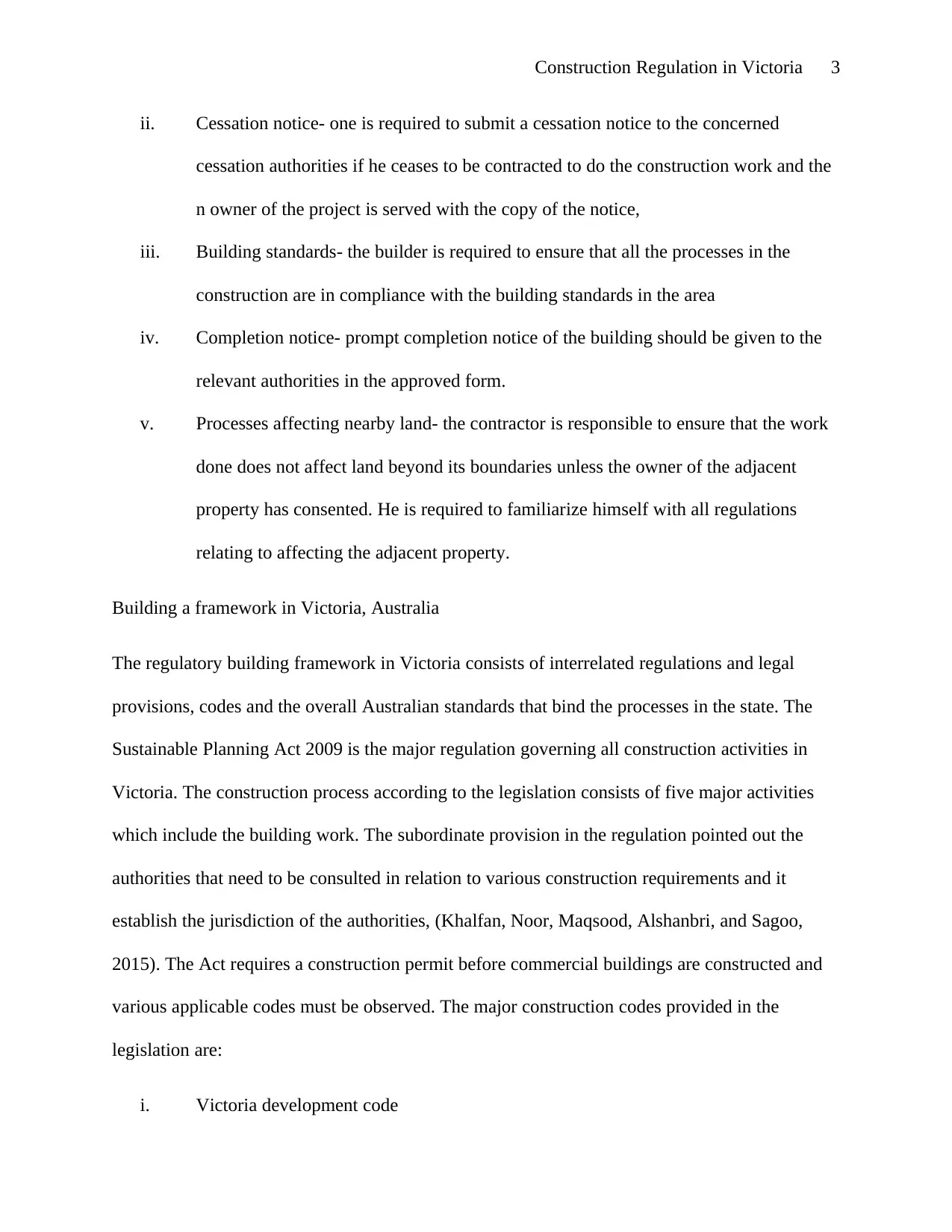
Construction Regulation in Victoria 3
ii. Cessation notice- one is required to submit a cessation notice to the concerned
cessation authorities if he ceases to be contracted to do the construction work and the
n owner of the project is served with the copy of the notice,
iii. Building standards- the builder is required to ensure that all the processes in the
construction are in compliance with the building standards in the area
iv. Completion notice- prompt completion notice of the building should be given to the
relevant authorities in the approved form.
v. Processes affecting nearby land- the contractor is responsible to ensure that the work
done does not affect land beyond its boundaries unless the owner of the adjacent
property has consented. He is required to familiarize himself with all regulations
relating to affecting the adjacent property.
Building a framework in Victoria, Australia
The regulatory building framework in Victoria consists of interrelated regulations and legal
provisions, codes and the overall Australian standards that bind the processes in the state. The
Sustainable Planning Act 2009 is the major regulation governing all construction activities in
Victoria. The construction process according to the legislation consists of five major activities
which include the building work. The subordinate provision in the regulation pointed out the
authorities that need to be consulted in relation to various construction requirements and it
establish the jurisdiction of the authorities, (Khalfan, Noor, Maqsood, Alshanbri, and Sagoo,
2015). The Act requires a construction permit before commercial buildings are constructed and
various applicable codes must be observed. The major construction codes provided in the
legislation are:
i. Victoria development code
ii. Cessation notice- one is required to submit a cessation notice to the concerned
cessation authorities if he ceases to be contracted to do the construction work and the
n owner of the project is served with the copy of the notice,
iii. Building standards- the builder is required to ensure that all the processes in the
construction are in compliance with the building standards in the area
iv. Completion notice- prompt completion notice of the building should be given to the
relevant authorities in the approved form.
v. Processes affecting nearby land- the contractor is responsible to ensure that the work
done does not affect land beyond its boundaries unless the owner of the adjacent
property has consented. He is required to familiarize himself with all regulations
relating to affecting the adjacent property.
Building a framework in Victoria, Australia
The regulatory building framework in Victoria consists of interrelated regulations and legal
provisions, codes and the overall Australian standards that bind the processes in the state. The
Sustainable Planning Act 2009 is the major regulation governing all construction activities in
Victoria. The construction process according to the legislation consists of five major activities
which include the building work. The subordinate provision in the regulation pointed out the
authorities that need to be consulted in relation to various construction requirements and it
establish the jurisdiction of the authorities, (Khalfan, Noor, Maqsood, Alshanbri, and Sagoo,
2015). The Act requires a construction permit before commercial buildings are constructed and
various applicable codes must be observed. The major construction codes provided in the
legislation are:
i. Victoria development code
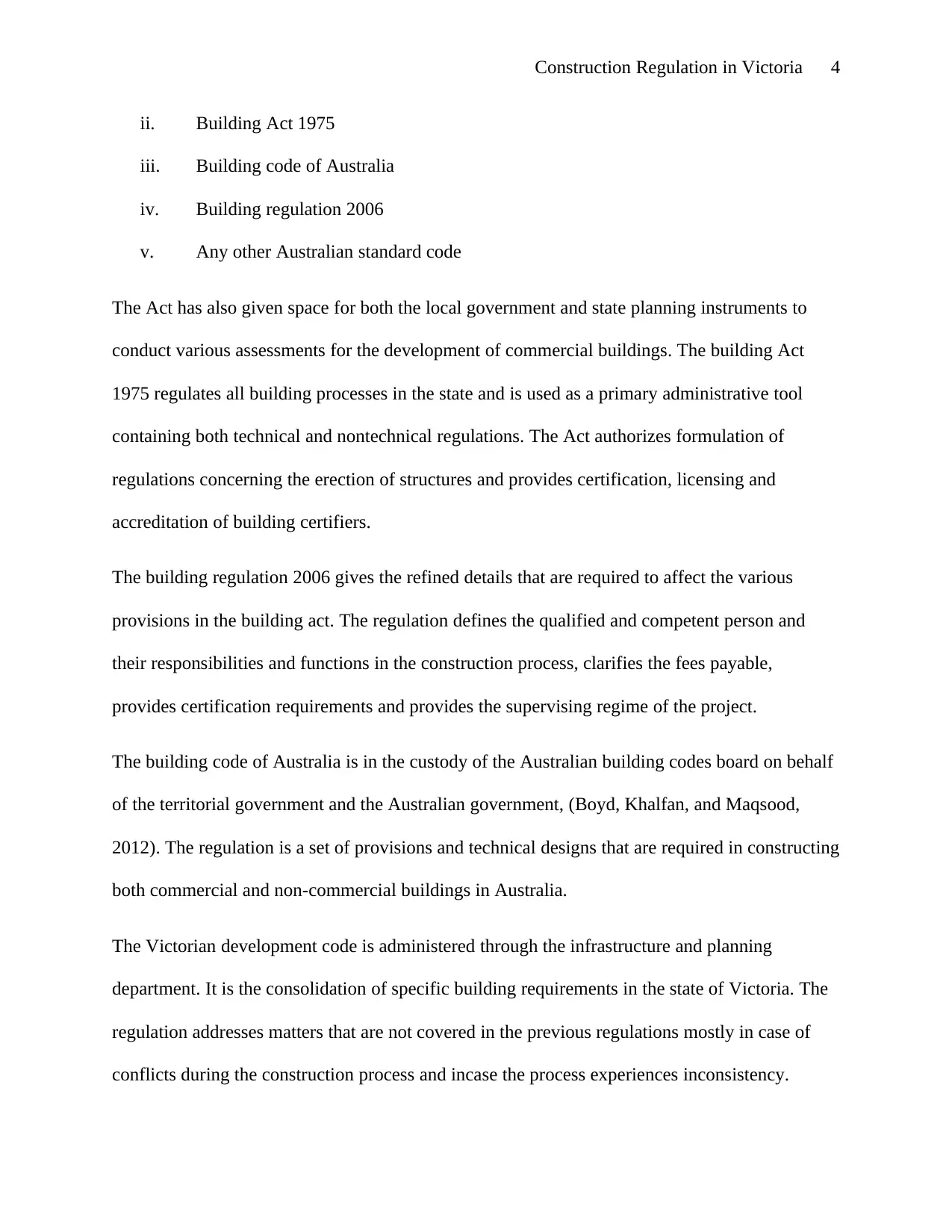
Construction Regulation in Victoria 4
ii. Building Act 1975
iii. Building code of Australia
iv. Building regulation 2006
v. Any other Australian standard code
The Act has also given space for both the local government and state planning instruments to
conduct various assessments for the development of commercial buildings. The building Act
1975 regulates all building processes in the state and is used as a primary administrative tool
containing both technical and nontechnical regulations. The Act authorizes formulation of
regulations concerning the erection of structures and provides certification, licensing and
accreditation of building certifiers.
The building regulation 2006 gives the refined details that are required to affect the various
provisions in the building act. The regulation defines the qualified and competent person and
their responsibilities and functions in the construction process, clarifies the fees payable,
provides certification requirements and provides the supervising regime of the project.
The building code of Australia is in the custody of the Australian building codes board on behalf
of the territorial government and the Australian government, (Boyd, Khalfan, and Maqsood,
2012). The regulation is a set of provisions and technical designs that are required in constructing
both commercial and non-commercial buildings in Australia.
The Victorian development code is administered through the infrastructure and planning
department. It is the consolidation of specific building requirements in the state of Victoria. The
regulation addresses matters that are not covered in the previous regulations mostly in case of
conflicts during the construction process and incase the process experiences inconsistency.
ii. Building Act 1975
iii. Building code of Australia
iv. Building regulation 2006
v. Any other Australian standard code
The Act has also given space for both the local government and state planning instruments to
conduct various assessments for the development of commercial buildings. The building Act
1975 regulates all building processes in the state and is used as a primary administrative tool
containing both technical and nontechnical regulations. The Act authorizes formulation of
regulations concerning the erection of structures and provides certification, licensing and
accreditation of building certifiers.
The building regulation 2006 gives the refined details that are required to affect the various
provisions in the building act. The regulation defines the qualified and competent person and
their responsibilities and functions in the construction process, clarifies the fees payable,
provides certification requirements and provides the supervising regime of the project.
The building code of Australia is in the custody of the Australian building codes board on behalf
of the territorial government and the Australian government, (Boyd, Khalfan, and Maqsood,
2012). The regulation is a set of provisions and technical designs that are required in constructing
both commercial and non-commercial buildings in Australia.
The Victorian development code is administered through the infrastructure and planning
department. It is the consolidation of specific building requirements in the state of Victoria. The
regulation addresses matters that are not covered in the previous regulations mostly in case of
conflicts during the construction process and incase the process experiences inconsistency.
Secure Best Marks with AI Grader
Need help grading? Try our AI Grader for instant feedback on your assignments.
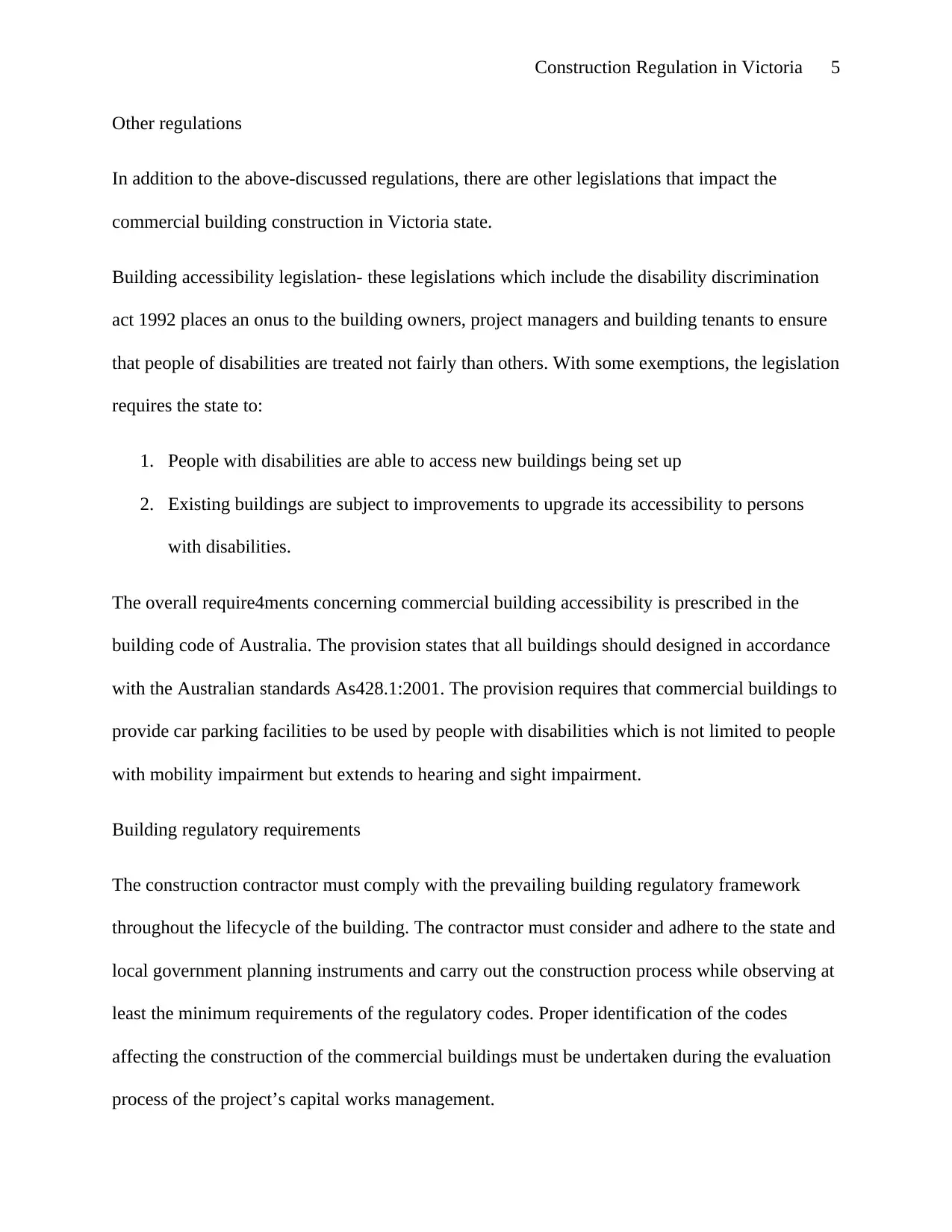
Construction Regulation in Victoria 5
Other regulations
In addition to the above-discussed regulations, there are other legislations that impact the
commercial building construction in Victoria state.
Building accessibility legislation- these legislations which include the disability discrimination
act 1992 places an onus to the building owners, project managers and building tenants to ensure
that people of disabilities are treated not fairly than others. With some exemptions, the legislation
requires the state to:
1. People with disabilities are able to access new buildings being set up
2. Existing buildings are subject to improvements to upgrade its accessibility to persons
with disabilities.
The overall require4ments concerning commercial building accessibility is prescribed in the
building code of Australia. The provision states that all buildings should designed in accordance
with the Australian standards As428.1:2001. The provision requires that commercial buildings to
provide car parking facilities to be used by people with disabilities which is not limited to people
with mobility impairment but extends to hearing and sight impairment.
Building regulatory requirements
The construction contractor must comply with the prevailing building regulatory framework
throughout the lifecycle of the building. The contractor must consider and adhere to the state and
local government planning instruments and carry out the construction process while observing at
least the minimum requirements of the regulatory codes. Proper identification of the codes
affecting the construction of the commercial buildings must be undertaken during the evaluation
process of the project’s capital works management.
Other regulations
In addition to the above-discussed regulations, there are other legislations that impact the
commercial building construction in Victoria state.
Building accessibility legislation- these legislations which include the disability discrimination
act 1992 places an onus to the building owners, project managers and building tenants to ensure
that people of disabilities are treated not fairly than others. With some exemptions, the legislation
requires the state to:
1. People with disabilities are able to access new buildings being set up
2. Existing buildings are subject to improvements to upgrade its accessibility to persons
with disabilities.
The overall require4ments concerning commercial building accessibility is prescribed in the
building code of Australia. The provision states that all buildings should designed in accordance
with the Australian standards As428.1:2001. The provision requires that commercial buildings to
provide car parking facilities to be used by people with disabilities which is not limited to people
with mobility impairment but extends to hearing and sight impairment.
Building regulatory requirements
The construction contractor must comply with the prevailing building regulatory framework
throughout the lifecycle of the building. The contractor must consider and adhere to the state and
local government planning instruments and carry out the construction process while observing at
least the minimum requirements of the regulatory codes. Proper identification of the codes
affecting the construction of the commercial buildings must be undertaken during the evaluation
process of the project’s capital works management.
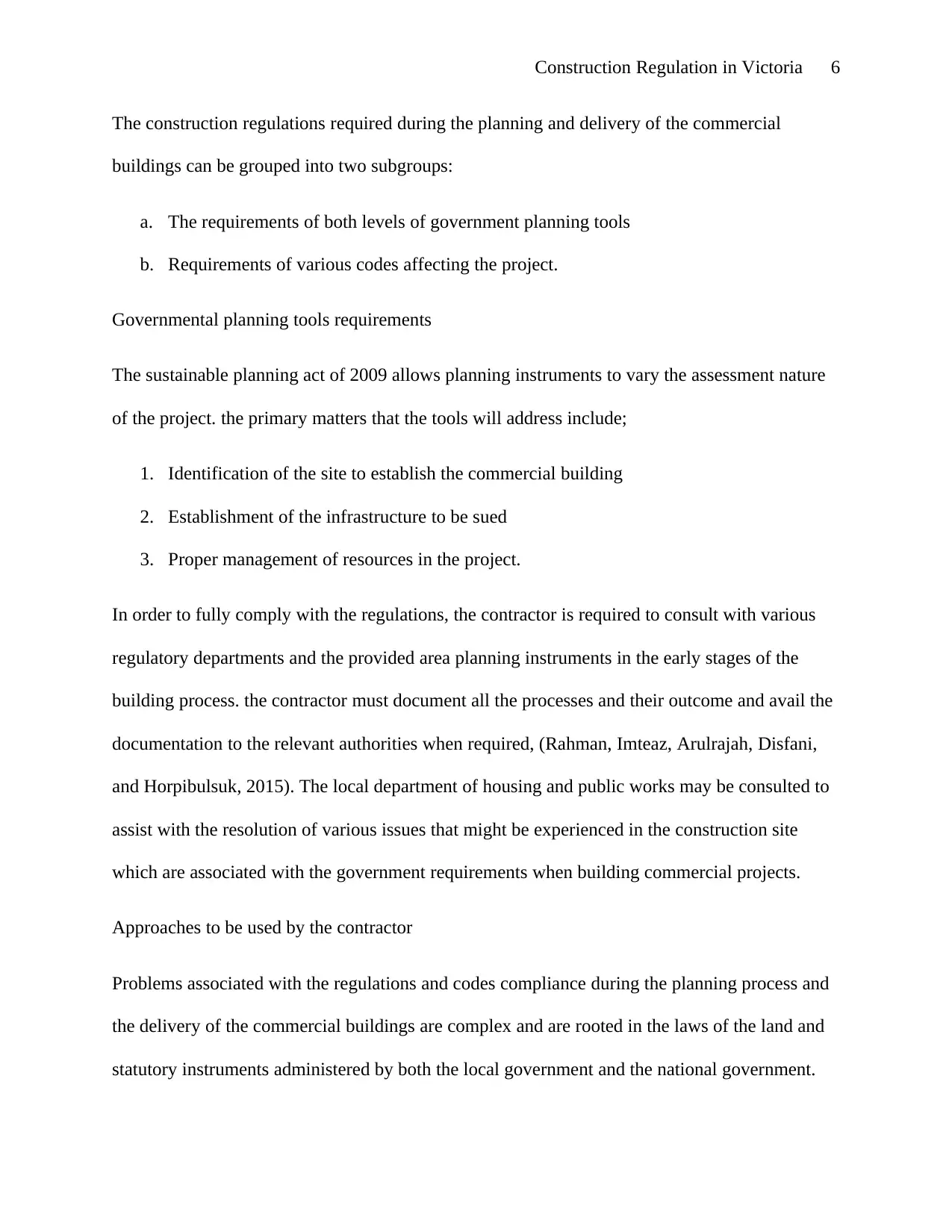
Construction Regulation in Victoria 6
The construction regulations required during the planning and delivery of the commercial
buildings can be grouped into two subgroups:
a. The requirements of both levels of government planning tools
b. Requirements of various codes affecting the project.
Governmental planning tools requirements
The sustainable planning act of 2009 allows planning instruments to vary the assessment nature
of the project. the primary matters that the tools will address include;
1. Identification of the site to establish the commercial building
2. Establishment of the infrastructure to be sued
3. Proper management of resources in the project.
In order to fully comply with the regulations, the contractor is required to consult with various
regulatory departments and the provided area planning instruments in the early stages of the
building process. the contractor must document all the processes and their outcome and avail the
documentation to the relevant authorities when required, (Rahman, Imteaz, Arulrajah, Disfani,
and Horpibulsuk, 2015). The local department of housing and public works may be consulted to
assist with the resolution of various issues that might be experienced in the construction site
which are associated with the government requirements when building commercial projects.
Approaches to be used by the contractor
Problems associated with the regulations and codes compliance during the planning process and
the delivery of the commercial buildings are complex and are rooted in the laws of the land and
statutory instruments administered by both the local government and the national government.
The construction regulations required during the planning and delivery of the commercial
buildings can be grouped into two subgroups:
a. The requirements of both levels of government planning tools
b. Requirements of various codes affecting the project.
Governmental planning tools requirements
The sustainable planning act of 2009 allows planning instruments to vary the assessment nature
of the project. the primary matters that the tools will address include;
1. Identification of the site to establish the commercial building
2. Establishment of the infrastructure to be sued
3. Proper management of resources in the project.
In order to fully comply with the regulations, the contractor is required to consult with various
regulatory departments and the provided area planning instruments in the early stages of the
building process. the contractor must document all the processes and their outcome and avail the
documentation to the relevant authorities when required, (Rahman, Imteaz, Arulrajah, Disfani,
and Horpibulsuk, 2015). The local department of housing and public works may be consulted to
assist with the resolution of various issues that might be experienced in the construction site
which are associated with the government requirements when building commercial projects.
Approaches to be used by the contractor
Problems associated with the regulations and codes compliance during the planning process and
the delivery of the commercial buildings are complex and are rooted in the laws of the land and
statutory instruments administered by both the local government and the national government.
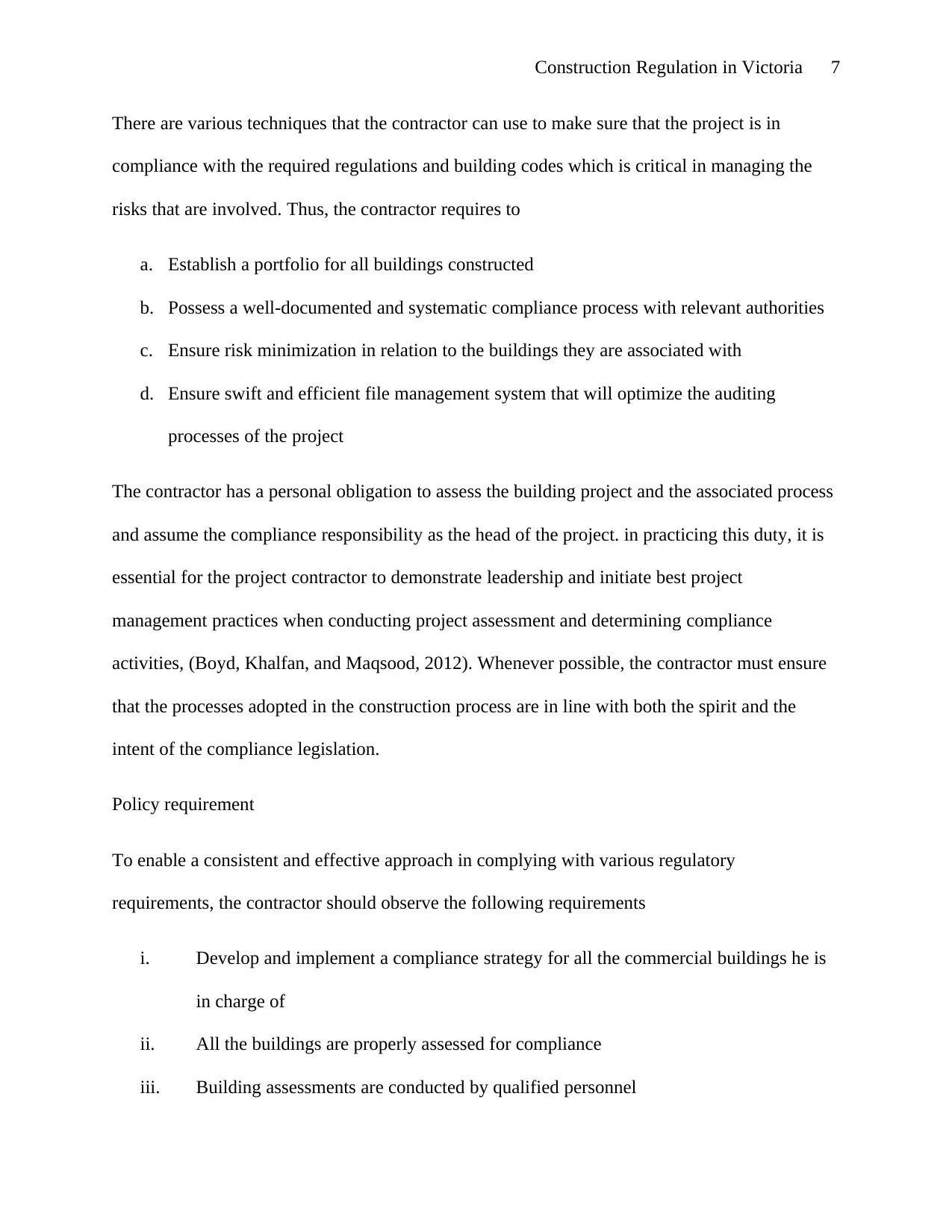
Construction Regulation in Victoria 7
There are various techniques that the contractor can use to make sure that the project is in
compliance with the required regulations and building codes which is critical in managing the
risks that are involved. Thus, the contractor requires to
a. Establish a portfolio for all buildings constructed
b. Possess a well-documented and systematic compliance process with relevant authorities
c. Ensure risk minimization in relation to the buildings they are associated with
d. Ensure swift and efficient file management system that will optimize the auditing
processes of the project
The contractor has a personal obligation to assess the building project and the associated process
and assume the compliance responsibility as the head of the project. in practicing this duty, it is
essential for the project contractor to demonstrate leadership and initiate best project
management practices when conducting project assessment and determining compliance
activities, (Boyd, Khalfan, and Maqsood, 2012). Whenever possible, the contractor must ensure
that the processes adopted in the construction process are in line with both the spirit and the
intent of the compliance legislation.
Policy requirement
To enable a consistent and effective approach in complying with various regulatory
requirements, the contractor should observe the following requirements
i. Develop and implement a compliance strategy for all the commercial buildings he is
in charge of
ii. All the buildings are properly assessed for compliance
iii. Building assessments are conducted by qualified personnel
There are various techniques that the contractor can use to make sure that the project is in
compliance with the required regulations and building codes which is critical in managing the
risks that are involved. Thus, the contractor requires to
a. Establish a portfolio for all buildings constructed
b. Possess a well-documented and systematic compliance process with relevant authorities
c. Ensure risk minimization in relation to the buildings they are associated with
d. Ensure swift and efficient file management system that will optimize the auditing
processes of the project
The contractor has a personal obligation to assess the building project and the associated process
and assume the compliance responsibility as the head of the project. in practicing this duty, it is
essential for the project contractor to demonstrate leadership and initiate best project
management practices when conducting project assessment and determining compliance
activities, (Boyd, Khalfan, and Maqsood, 2012). Whenever possible, the contractor must ensure
that the processes adopted in the construction process are in line with both the spirit and the
intent of the compliance legislation.
Policy requirement
To enable a consistent and effective approach in complying with various regulatory
requirements, the contractor should observe the following requirements
i. Develop and implement a compliance strategy for all the commercial buildings he is
in charge of
ii. All the buildings are properly assessed for compliance
iii. Building assessments are conducted by qualified personnel
Paraphrase This Document
Need a fresh take? Get an instant paraphrase of this document with our AI Paraphraser
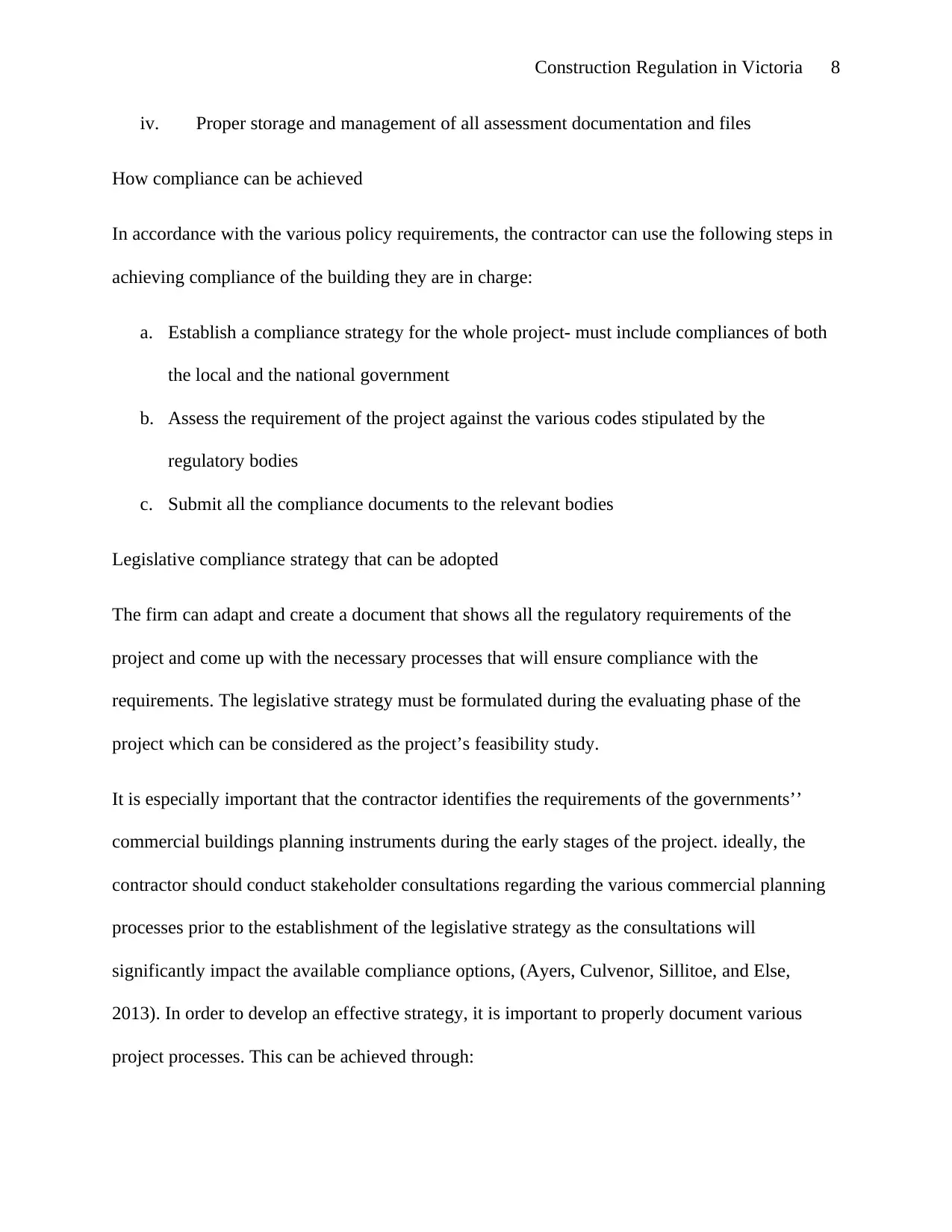
Construction Regulation in Victoria 8
iv. Proper storage and management of all assessment documentation and files
How compliance can be achieved
In accordance with the various policy requirements, the contractor can use the following steps in
achieving compliance of the building they are in charge:
a. Establish a compliance strategy for the whole project- must include compliances of both
the local and the national government
b. Assess the requirement of the project against the various codes stipulated by the
regulatory bodies
c. Submit all the compliance documents to the relevant bodies
Legislative compliance strategy that can be adopted
The firm can adapt and create a document that shows all the regulatory requirements of the
project and come up with the necessary processes that will ensure compliance with the
requirements. The legislative strategy must be formulated during the evaluating phase of the
project which can be considered as the project’s feasibility study.
It is especially important that the contractor identifies the requirements of the governments’’
commercial buildings planning instruments during the early stages of the project. ideally, the
contractor should conduct stakeholder consultations regarding the various commercial planning
processes prior to the establishment of the legislative strategy as the consultations will
significantly impact the available compliance options, (Ayers, Culvenor, Sillitoe, and Else,
2013). In order to develop an effective strategy, it is important to properly document various
project processes. This can be achieved through:
iv. Proper storage and management of all assessment documentation and files
How compliance can be achieved
In accordance with the various policy requirements, the contractor can use the following steps in
achieving compliance of the building they are in charge:
a. Establish a compliance strategy for the whole project- must include compliances of both
the local and the national government
b. Assess the requirement of the project against the various codes stipulated by the
regulatory bodies
c. Submit all the compliance documents to the relevant bodies
Legislative compliance strategy that can be adopted
The firm can adapt and create a document that shows all the regulatory requirements of the
project and come up with the necessary processes that will ensure compliance with the
requirements. The legislative strategy must be formulated during the evaluating phase of the
project which can be considered as the project’s feasibility study.
It is especially important that the contractor identifies the requirements of the governments’’
commercial buildings planning instruments during the early stages of the project. ideally, the
contractor should conduct stakeholder consultations regarding the various commercial planning
processes prior to the establishment of the legislative strategy as the consultations will
significantly impact the available compliance options, (Ayers, Culvenor, Sillitoe, and Else,
2013). In order to develop an effective strategy, it is important to properly document various
project processes. This can be achieved through:
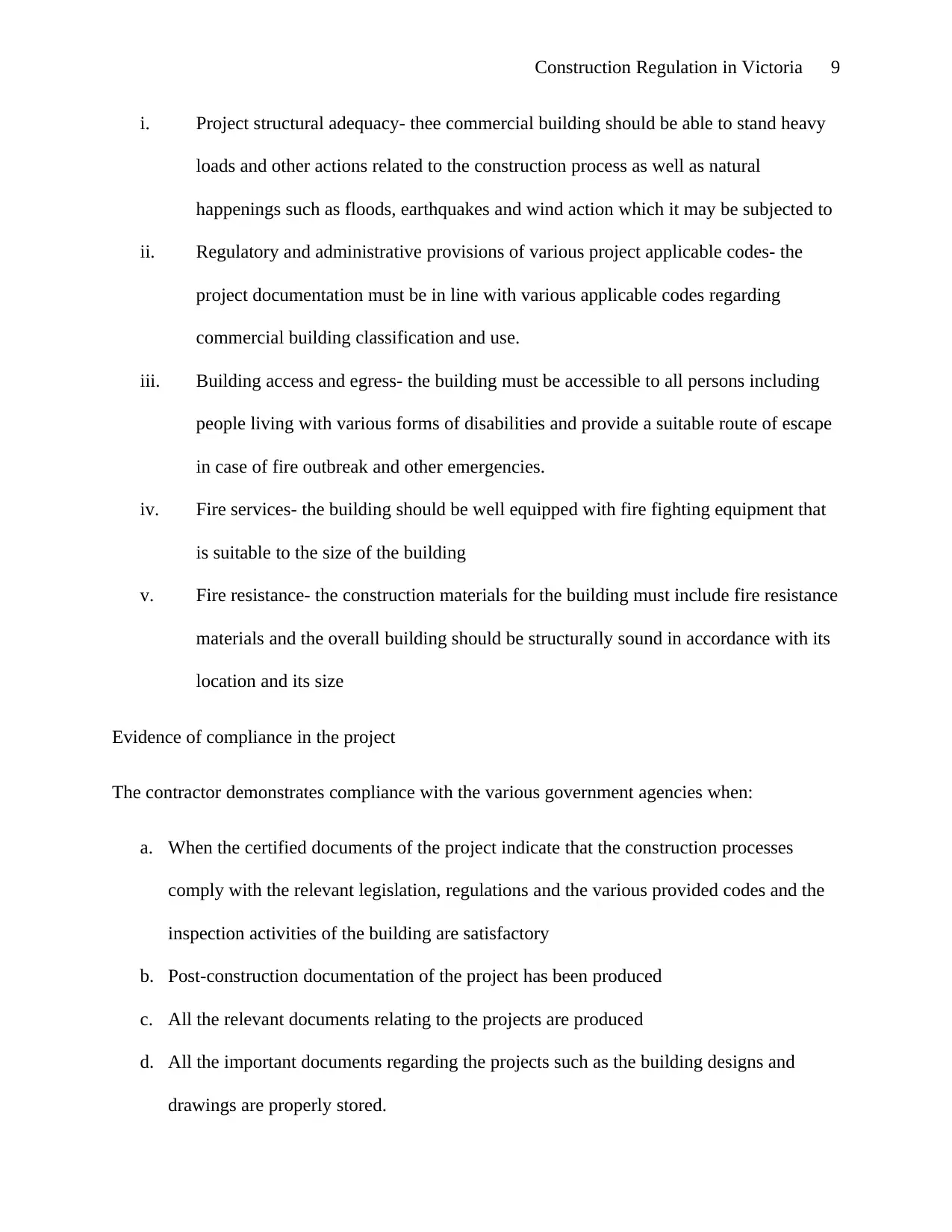
Construction Regulation in Victoria 9
i. Project structural adequacy- thee commercial building should be able to stand heavy
loads and other actions related to the construction process as well as natural
happenings such as floods, earthquakes and wind action which it may be subjected to
ii. Regulatory and administrative provisions of various project applicable codes- the
project documentation must be in line with various applicable codes regarding
commercial building classification and use.
iii. Building access and egress- the building must be accessible to all persons including
people living with various forms of disabilities and provide a suitable route of escape
in case of fire outbreak and other emergencies.
iv. Fire services- the building should be well equipped with fire fighting equipment that
is suitable to the size of the building
v. Fire resistance- the construction materials for the building must include fire resistance
materials and the overall building should be structurally sound in accordance with its
location and its size
Evidence of compliance in the project
The contractor demonstrates compliance with the various government agencies when:
a. When the certified documents of the project indicate that the construction processes
comply with the relevant legislation, regulations and the various provided codes and the
inspection activities of the building are satisfactory
b. Post-construction documentation of the project has been produced
c. All the relevant documents relating to the projects are produced
d. All the important documents regarding the projects such as the building designs and
drawings are properly stored.
i. Project structural adequacy- thee commercial building should be able to stand heavy
loads and other actions related to the construction process as well as natural
happenings such as floods, earthquakes and wind action which it may be subjected to
ii. Regulatory and administrative provisions of various project applicable codes- the
project documentation must be in line with various applicable codes regarding
commercial building classification and use.
iii. Building access and egress- the building must be accessible to all persons including
people living with various forms of disabilities and provide a suitable route of escape
in case of fire outbreak and other emergencies.
iv. Fire services- the building should be well equipped with fire fighting equipment that
is suitable to the size of the building
v. Fire resistance- the construction materials for the building must include fire resistance
materials and the overall building should be structurally sound in accordance with its
location and its size
Evidence of compliance in the project
The contractor demonstrates compliance with the various government agencies when:
a. When the certified documents of the project indicate that the construction processes
comply with the relevant legislation, regulations and the various provided codes and the
inspection activities of the building are satisfactory
b. Post-construction documentation of the project has been produced
c. All the relevant documents relating to the projects are produced
d. All the important documents regarding the projects such as the building designs and
drawings are properly stored.
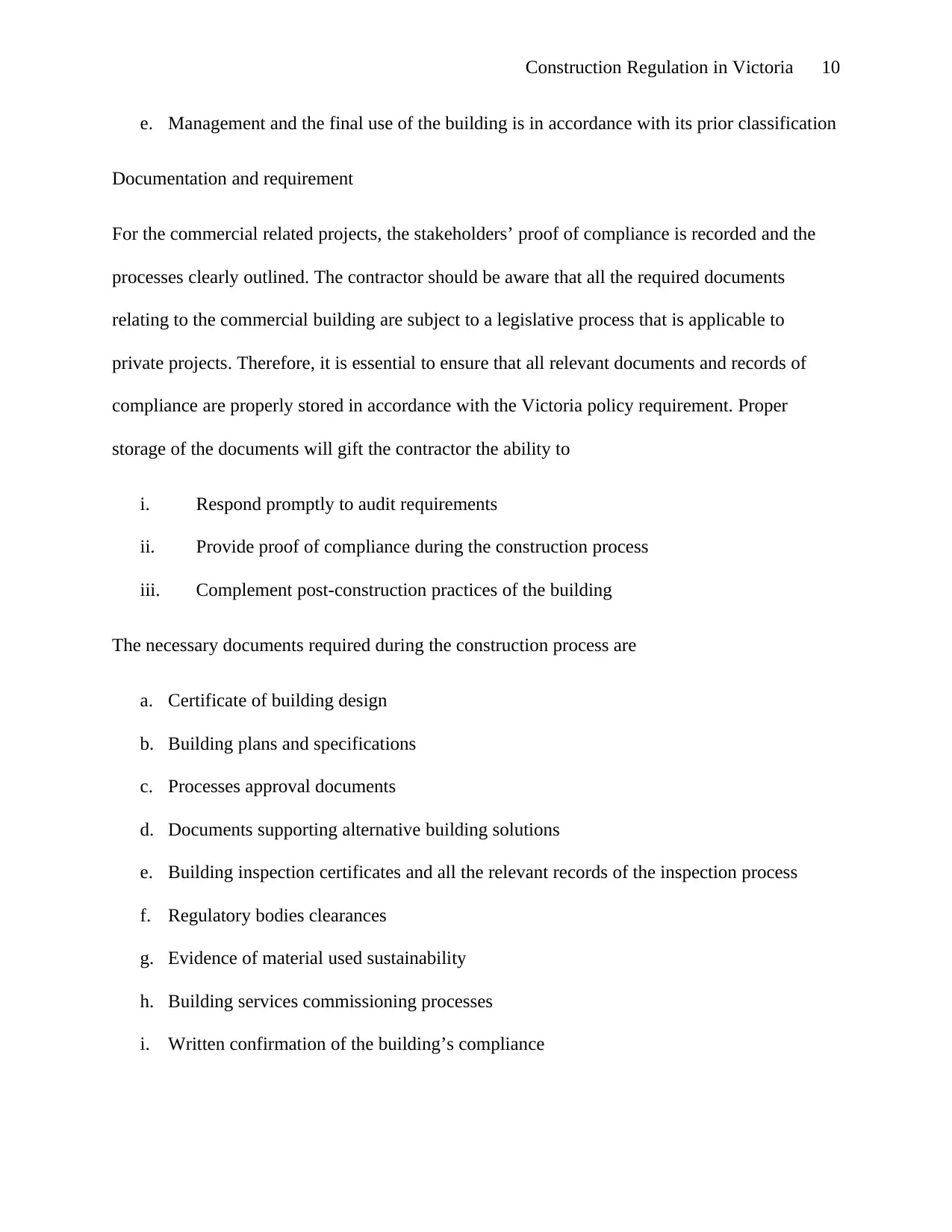
Construction Regulation in Victoria 10
e. Management and the final use of the building is in accordance with its prior classification
Documentation and requirement
For the commercial related projects, the stakeholders’ proof of compliance is recorded and the
processes clearly outlined. The contractor should be aware that all the required documents
relating to the commercial building are subject to a legislative process that is applicable to
private projects. Therefore, it is essential to ensure that all relevant documents and records of
compliance are properly stored in accordance with the Victoria policy requirement. Proper
storage of the documents will gift the contractor the ability to
i. Respond promptly to audit requirements
ii. Provide proof of compliance during the construction process
iii. Complement post-construction practices of the building
The necessary documents required during the construction process are
a. Certificate of building design
b. Building plans and specifications
c. Processes approval documents
d. Documents supporting alternative building solutions
e. Building inspection certificates and all the relevant records of the inspection process
f. Regulatory bodies clearances
g. Evidence of material used sustainability
h. Building services commissioning processes
i. Written confirmation of the building’s compliance
e. Management and the final use of the building is in accordance with its prior classification
Documentation and requirement
For the commercial related projects, the stakeholders’ proof of compliance is recorded and the
processes clearly outlined. The contractor should be aware that all the required documents
relating to the commercial building are subject to a legislative process that is applicable to
private projects. Therefore, it is essential to ensure that all relevant documents and records of
compliance are properly stored in accordance with the Victoria policy requirement. Proper
storage of the documents will gift the contractor the ability to
i. Respond promptly to audit requirements
ii. Provide proof of compliance during the construction process
iii. Complement post-construction practices of the building
The necessary documents required during the construction process are
a. Certificate of building design
b. Building plans and specifications
c. Processes approval documents
d. Documents supporting alternative building solutions
e. Building inspection certificates and all the relevant records of the inspection process
f. Regulatory bodies clearances
g. Evidence of material used sustainability
h. Building services commissioning processes
i. Written confirmation of the building’s compliance
Secure Best Marks with AI Grader
Need help grading? Try our AI Grader for instant feedback on your assignments.
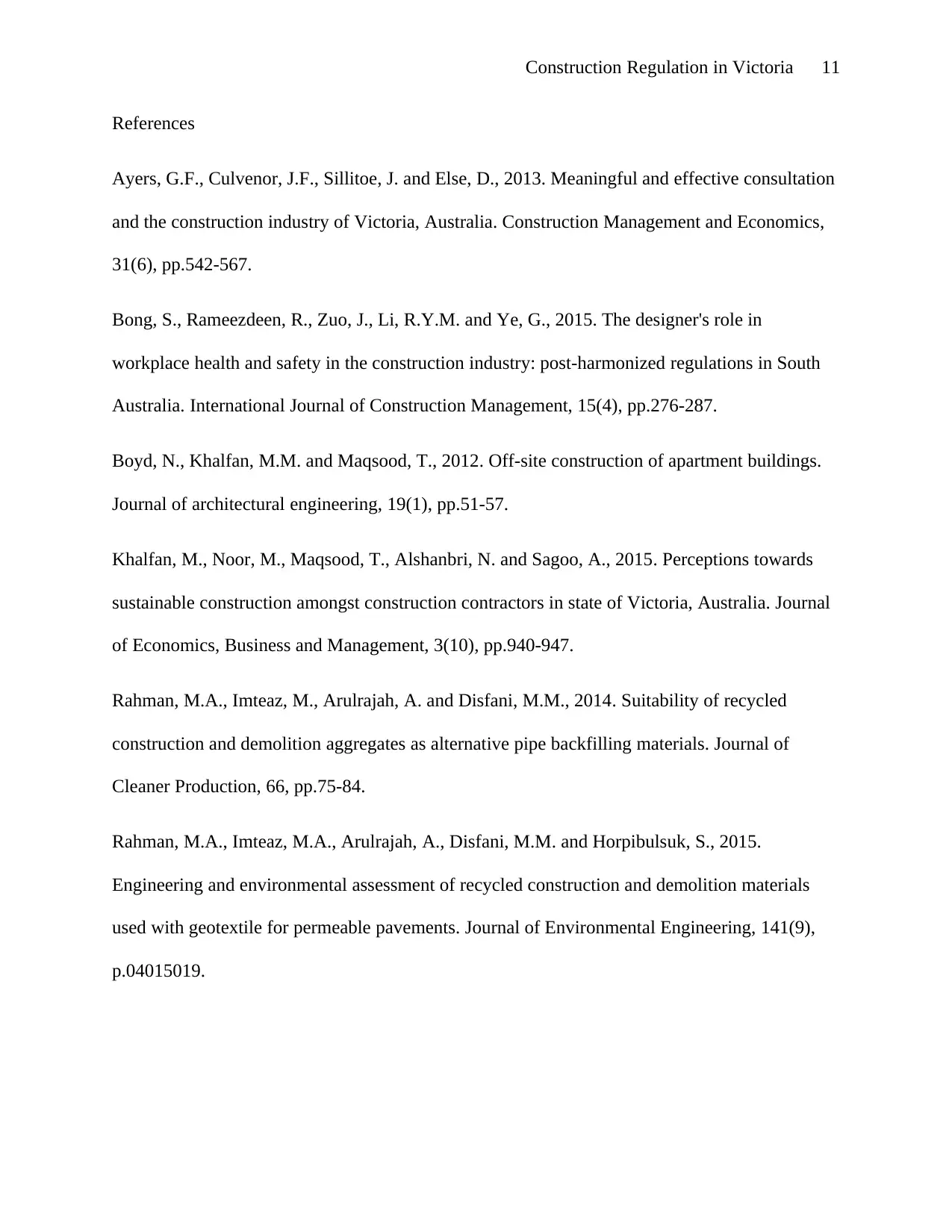
Construction Regulation in Victoria 11
References
Ayers, G.F., Culvenor, J.F., Sillitoe, J. and Else, D., 2013. Meaningful and effective consultation
and the construction industry of Victoria, Australia. Construction Management and Economics,
31(6), pp.542-567.
Bong, S., Rameezdeen, R., Zuo, J., Li, R.Y.M. and Ye, G., 2015. The designer's role in
workplace health and safety in the construction industry: post-harmonized regulations in South
Australia. International Journal of Construction Management, 15(4), pp.276-287.
Boyd, N., Khalfan, M.M. and Maqsood, T., 2012. Off-site construction of apartment buildings.
Journal of architectural engineering, 19(1), pp.51-57.
Khalfan, M., Noor, M., Maqsood, T., Alshanbri, N. and Sagoo, A., 2015. Perceptions towards
sustainable construction amongst construction contractors in state of Victoria, Australia. Journal
of Economics, Business and Management, 3(10), pp.940-947.
Rahman, M.A., Imteaz, M., Arulrajah, A. and Disfani, M.M., 2014. Suitability of recycled
construction and demolition aggregates as alternative pipe backfilling materials. Journal of
Cleaner Production, 66, pp.75-84.
Rahman, M.A., Imteaz, M.A., Arulrajah, A., Disfani, M.M. and Horpibulsuk, S., 2015.
Engineering and environmental assessment of recycled construction and demolition materials
used with geotextile for permeable pavements. Journal of Environmental Engineering, 141(9),
p.04015019.
References
Ayers, G.F., Culvenor, J.F., Sillitoe, J. and Else, D., 2013. Meaningful and effective consultation
and the construction industry of Victoria, Australia. Construction Management and Economics,
31(6), pp.542-567.
Bong, S., Rameezdeen, R., Zuo, J., Li, R.Y.M. and Ye, G., 2015. The designer's role in
workplace health and safety in the construction industry: post-harmonized regulations in South
Australia. International Journal of Construction Management, 15(4), pp.276-287.
Boyd, N., Khalfan, M.M. and Maqsood, T., 2012. Off-site construction of apartment buildings.
Journal of architectural engineering, 19(1), pp.51-57.
Khalfan, M., Noor, M., Maqsood, T., Alshanbri, N. and Sagoo, A., 2015. Perceptions towards
sustainable construction amongst construction contractors in state of Victoria, Australia. Journal
of Economics, Business and Management, 3(10), pp.940-947.
Rahman, M.A., Imteaz, M., Arulrajah, A. and Disfani, M.M., 2014. Suitability of recycled
construction and demolition aggregates as alternative pipe backfilling materials. Journal of
Cleaner Production, 66, pp.75-84.
Rahman, M.A., Imteaz, M.A., Arulrajah, A., Disfani, M.M. and Horpibulsuk, S., 2015.
Engineering and environmental assessment of recycled construction and demolition materials
used with geotextile for permeable pavements. Journal of Environmental Engineering, 141(9),
p.04015019.
1 out of 11
Related Documents
Your All-in-One AI-Powered Toolkit for Academic Success.
+13062052269
info@desklib.com
Available 24*7 on WhatsApp / Email
![[object Object]](/_next/static/media/star-bottom.7253800d.svg)
Unlock your academic potential
© 2024 | Zucol Services PVT LTD | All rights reserved.





